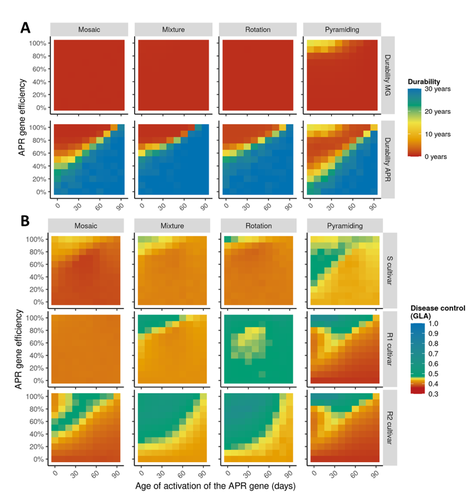
Plant resistance to pathogens: just you wait?

Durable resistance or efficient disease control? Adult Plant Resistance (APR) at the heart of the dilemma
Abstract
Recommendation: posted 01 May 2023, validated 02 May 2023
Poisot, T. (2023) Plant resistance to pathogens: just you wait?. Peer Community in Evolutionary Biology, 100628. https://doi.org/10.24072/pci.evolbiol.100628
Recommendation
In this preprint, Rimbaud et al. (2023) examine whether Adult Plant Resistance (APR), where plants delay their response to pathogens, is a viable alternative when the solution to evolve complete resistance from the seedling stage exists. At first glance, delaying resistance seems like a counter-intuitive strategy, unless it can result in a weaker selection of the pathogen, and therefore slow down its adaption to plant resistance.
The approach of Rimbaud et al. is to incorporate as much of the mechanisms as possible into a model. By accounting for explicit spatio-temporal dynamics, stochasticity, and the coupling between demography and population genetics, to simulate an agricultural landscape, they reach a nuanced conclusion.
Weaker and delayed activation of genes that confer APR does indeed reduce the selection pressure acting on the pathogen, at the cost of overall less effective protection. The alternative strategy of rapid or complete activation of these genes, although it results in better results in defending against the pathogen, is at risk of being overcome because it introduces a stronger selection pressure.
One important feature of this work is that it accounts for agricultural practices. The landscape that is simulated can account for monoculture, mosaic cultures, mixed cultures, and rotations of crops (with different strategies for resistance). This introduces an interesting element to the conclusion: that human practices will have an impact on the selection pressures acting within the system.
Perhaps the most striking result is that, for the plants, it might be more beneficial to bear the cost of a wild-type pathogen that can benefit from delayed activation of resistance, and therefore exclude the more virulent strains by simply being there first, and essentially buying the plant some time before it activates its resistance more completely. When the landscape is aggregated, even wild-type pathogens can cause severe epidemics; increasing fragmentation, because it enables connectivity between patches of plants with different strategies, allows pathogens to move across cultivars, and reduces the epidemic risk on susceptible plants.
These results should encourage scaling up the perspective on APR, and indeed Rimbaud et al. adopt a landscape-scale perspective, to show that APR genes and genes conferring more complete resistance early on can have synergistic effects. This is, again, both an interesting result for evolutionary biologists, but also a useful way to prioritize different crop management strategies over large spatial scales.
References
Rimbaud, Loup, et al. Durable Resistance or Efficient Disease Control? Adult Plant Resistance (APR) at the Heart of the Dilemma. 2023. bioRxiv, ver. 2 peer-reviewed and recommended by Peer Community in Evolutionary Biology. https://doi.org/10.1101/2022.08.30.505787
The recommender in charge of the evaluation of the article and the reviewers declared that they have no conflict of interest (as defined in the code of conduct of PCI) with the authors or with the content of the article. The authors declared that they comply with the PCI rule of having no financial conflicts of interest in relation to the content of the article.
This work benefited from GRDC grant CSP00192, ANR project “ArchiV” (2019–2023, grant n°ANR-18-CE32-0004-01), AFB Ecophyto II-Leviers Territoriaux Project “Médée” (2020–2022), and the CSIRO/INRAE linkage program
Evaluation round #1
DOI or URL of the preprint: https://doi.org/10.1101/2022.08.30.505787
Version of the preprint: 1
Author's Reply, 17 Apr 2023
Decision by Timothée Poisot, posted 19 Mar 2023, validated 20 Mar 2023
Dear authors,
I would like to apologize for the delay in returning a decision. We had to invite many reviewers in order to secure two reviews.
I have now received two reviews, and they are positive about the manuscript, but request modifications (that are very minor), mostly to clarify how the model works (which, I think, can be addressed in an appendix), or how the model's simulations are transformed in measurements (which, I believe, should be in the main text).
Please provide a point by point response to the comments; I do not anticipate having to send the preprint out for review again, so please do make sure the response is detailed enough that I can write my recommendation when it is resubmitted.
Montréal, March 19, 2023
Timothée Poisot










